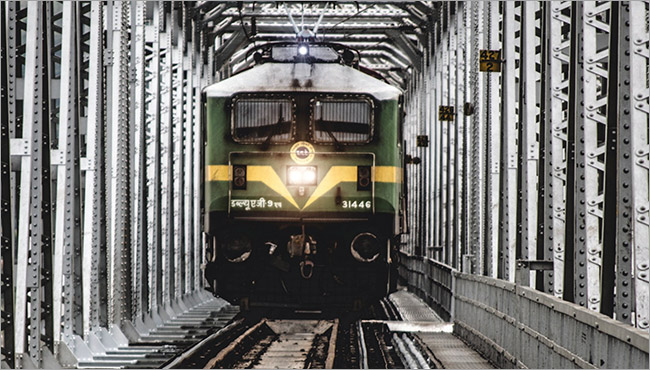-
CENTRES
Progammes & Centres
Location
Even though India might benefit from weak energy prices, industries exiting China, it’s going to get harder to compete in manufacturing.

India is currently in the midst of two large but different endeavours.
The first is to complete the unfinished agenda of the previous decade, providing the country with the modern infrastructure, rural amenities, social services, and connectivity that any developed economy needs. And the second, the most ambitious of the two, is to create jobs, wealth, and value to accommodate a young and aspiring population, eradicate poverty, and boost GDP growth. But these two projects are being undertaken at a time when global headwinds are deeply unfavourable. Today there are five hurdles that stand between India and its ambition to join the club of developed economies. The first is the advent of this new age where the open, free, and democratic global trading system has become a pale shadow of its previous self. The multilateral trading system — and the preference for this kind of model — has waned considerably. It is being replaced by free trade arrangements between smaller groups of countries and regions, where a handful of stakeholders are able to decide the terms of trade. This is coupled with a stagnation in global financial flows, because of weak growth, and the growing disquiet over globalisation, curiously enough, in the developed world. From the EU to the UK to the US, politicians are using globalisation as a convenient culprit for all that ails domestic economies and societies. It’s against this backdrop that India has to discover new markets, new sources of funding, and new trading arrangements. Second, the advance of technology and the expansion of the digital economy, along with robotisation, is in many ways closing the window for export-led manufacturing growth. They have significantly eroded the advantages that cheap labour typically provide for developing countries. Industrialisation, when seen through the narrow prism of manufacturing, therefore already looks improbable, if not impossible. Emerging economies will be stuck with the traditional disadvantages of weak governance, cumbersome bureaucracies, quality and competence issues, fragile supply chains, and a lack of skilled labour even as they compete with machines and machine learning. Large labour pools are unlikely to provide any competitive advantage unless the labour force is reoriented, retrained, and reimagined.
That’s going to make things difficult for India. Even though the country might benefit in the next five to 10 years from weak energy prices, industries exiting China, and inflows of foreign direct investment, it’s going to get harder to compete in manufacturing.
Emerging economies will be stuck with the traditional disadvantages of weak governance, cumbersome bureaucracies, quality and competence issues, fragile supply chains, and a lack of skilled labour even as they compete with machines and machine learning. Large labour pools are unlikely to provide any competitive advantage unless the labour force is reoriented, retrained, and reimagined.
That’s going to make things difficult for India. Even though the country might benefit in the next five to 10 years from weak energy prices, industries exiting China, and inflows of foreign direct investment, it’s going to get harder to compete in manufacturing.
 And there are other government policies that also fit well with this endeavour: "Digital India" knits markets together, allowing for vast e-commerce and business-to-business opportunities, and "Start-up India" gives new entrepreneurs access to the finance and incubation required for them to take advantage of these opportunities.
Secondly, the attitude towards informal employment needs to change. It’s time to stop thinking of the informal economy as a bad thing, particularly since an overwhelmingly large number of Indian workers (over 90% by some estimates) are currently employed in the sector. The government should instead focus on creating support systems that will allow for India’s vast informal workforce to become more secure, productive, and, where feasible, more entrepreneurial.
Finally, India must think big. It must consider the possibility that it will have to leapfrog over the industrialisation process itself. It must imagine itself becoming the epicentre of the robotics and AI world, much like Japan become the hub for electronics, Germany for automobiles, and China for manufacturing everything at a tenth of the cost.
To prosper in a world that is suffering from the absence of growth and the disruption of old models, India must strive to become the principal stakeholder of the digital revolution — and ensure that its teeming millions partake in it gainfully, even if informally.
This commentary originally appeared in Quartz India.
And there are other government policies that also fit well with this endeavour: "Digital India" knits markets together, allowing for vast e-commerce and business-to-business opportunities, and "Start-up India" gives new entrepreneurs access to the finance and incubation required for them to take advantage of these opportunities.
Secondly, the attitude towards informal employment needs to change. It’s time to stop thinking of the informal economy as a bad thing, particularly since an overwhelmingly large number of Indian workers (over 90% by some estimates) are currently employed in the sector. The government should instead focus on creating support systems that will allow for India’s vast informal workforce to become more secure, productive, and, where feasible, more entrepreneurial.
Finally, India must think big. It must consider the possibility that it will have to leapfrog over the industrialisation process itself. It must imagine itself becoming the epicentre of the robotics and AI world, much like Japan become the hub for electronics, Germany for automobiles, and China for manufacturing everything at a tenth of the cost.
To prosper in a world that is suffering from the absence of growth and the disruption of old models, India must strive to become the principal stakeholder of the digital revolution — and ensure that its teeming millions partake in it gainfully, even if informally.
This commentary originally appeared in Quartz India.
The views expressed above belong to the author(s). ORF research and analyses now available on Telegram! Click here to access our curated content — blogs, longforms and interviews.

Samir Saran is the President of the Observer Research Foundation (ORF), India’s premier think tank, headquartered in New Delhi with affiliates in North America and ...
Read More +